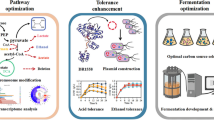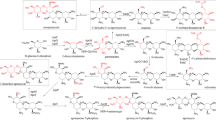Abstract
Strain AJ1678, an Azotobacter vinelandii mutant overproducing the storage polymer poly-β-hydroxybutyrate (PHB) in solid but not liquid complex medium with sucrose, was isolated after mini-Tn5 mutagenesis of strain UW136. Cloning and nucleotide sequencing of the affected locus led to identification of pycA, encoding a protein with high identity to the biotin carboxylase subunit of pyruvate carboxylase enzyme (PYC). A gene (pycB) whose product is similar to the biotin-carrying subunit of PYC is present immediately downstream from pycA. An assay of pyruvate carboxylase activity and an avidin-blot analysis confirmed that pycA and pycB encode the two subunits of this enzyme. In many organisms, PYC catalyzes ATP-dependent carboxylation of pyruvate to generate oxaloacetate and is responsible for replenishing oxaloacetate for continued operation of the tricarboxylic acid cycle. We propose that the pycA mutation causes a slow-down in the TCA cycle activity due to a low oxaloacetate concentration, resulting in a higher availability of acetyl-CoA for the synthesis of poly-β-hydroxybutyrate.





Similar content being viewed by others
References
Anderson AJ, Dawes EA (1990) Occurrence, metabolism, metabolic role, and industrial uses of bacterial polyhydroxyalkanoates. Microbiol Rev 54:450–472
Bali A, Blanco G, Hill S, Kennedy K (1992) Excretion of ammonium by a nifL mutant of Azotobacter vinelandii fixing nitrogen. Appl Environ Microbiol 58:1711–1718
Bishop PE, Brill WJ (1977) Genetic analysis of Azotobacter vinelandii mutant strains unable to fix nitrogen. J Bacteriol 130:954–956
De Lorenzo V, Herrero M, Jakubzik V, Timmis KN (1990) Mini-Tn5 transposon derivatives for insertion mutagenesis, promoter probing and chromosomal insertion of cloned DNA in gram-negative eubacteria. J Bacteriol 172:6568–6572
Gokarn RR, Evans JD, Walker JR, Martin SA, Eiteman MA, Altman E (2001) The physiological effects and metabolic alterations caused by the expression of Rhizobium etli pyruvate carboxylase in Escherichia coli. Appl Microbiol Biotechnol 56:188–195
Goss JA, Cohen ND, Utter MF (1981) Characterization of the subunit structure of pyruvate carboxylase from Pseudomonas citronellolis. J Biol Chem 256:11819–11825
Jitrapakdee S, Wallace JC (1999) Structure, function and regulation of pyruvate carboxylase. Biochem J 340:1–16
Kennedy C, Gamal R, Humphrey R, Ramos J, Brigle K, Dean D (1986) The nifH, nifM and nifN genes of Azotobacter vinelandii: characterization by Tn5 mutagenesis and isolation from pLARF1 gene banks. Mol Gen Genet 205:318–325
Law JH, Slepecky RA (1961) Assay of poly-β-hydroxybutyric acid. J Bacteriol 82:33–36
Liao CL, Atkinson DE (1971) Regulation at the phosphoenolpyruvate branchpoint in Azotobacter vinelandii: phosphoenolpyruvate carboxylase. J Bacteriol 106:31–36
Manchak J, Page WJ (1994) Control of polyhydroxyalkanoate synthesis in Azotobacter vinelandii strain UWD. Microbiology 140:953–963
Mejía-Ruíz H, Moreno S, Guzmán J, Nájera R, León R, Soberón-Chavez G, Espín G (1997) Isolation and characterization of an Azotobacter vinelandii algK mutant. FEMS Microbiol Lett 156:101–106
Mukhopadhyay B, Stoddard SF, Wolfe RS (1998) Purification, regulation and molecular and biochemical characterization of pyruvate carboxylase from Methanobacterium thermoautotrophicum Strain ΔH. J Biol Chem 273:5155–5166
Mukhopadhyay B, Patel VJ, Wolfe RS (2000) A stable archeal pyruvate carboxylase from the hyperthermophile Methanococus jannaschii. Arch Microbiol 174:406–414
Mukhopadhyay B, Purwantini E, Kreder CL, Wolfe RS (2001) Oxalacetate synthesis in the methanarchaeon Methanosarcina barkeri: pyruvate carboxylase genes and a putative Escherichia coli-type bifunctional biotin protein ligase gene (bpl/birA) exhibit a unique organization. J Bacteriol 183:3804–3810
Nelson K, Paulsen I, Weinel C, Dodson R, Hilbert H, Fouts D, Gill S, Pop M, Martins Dos Santos V, Holmes M, Brinkac L, Beanan M, DeBoy R, Daugherty S, Kolonay J, Madupu R, Nelson W, White O, Peterson J, Khouri H, Hance I, Lee P, Holtzapple E, Scanlan D, Tran K, Moazzez A, Utterback T, Rizzo M, Lee K, Kosack D, Moestl D, Wedler H, Lauber J, Hoheisel J, Straetz M, Heim S, Kiewitz C, Eisen J, Timmis K, Duesterhoft A, Tummler B, Fraser C (2002) Complete genome sequence and comparative analysis of the metabolically versatile Pseudomonas putida KT2440. Environ Microbiol 4:799–808
Omata T, Gohta S, Takahashi Y, Harano Y, and Maeda S (2001) Involvement of a CbbR homolog in low CO2-induced activation of the bicarbonate transporter operon in cyanobacteria. J Bacteriol 183:1891–1898
Peters-Wendisch PG, Kreutzer C, Kalinowski J, Pátek M, Sahm H, Eikmanns BJ (1998) Pyruvate carboxylase from Corynebacterium glutamicum: characterization, expression and inactivation of the pyc gene. Microbiology 144:915–927
Sambrook J, Fritsch EF, Maniatis T (1989) Molecular cloning: a laboratory manual, 2nd edn. Cold Spring Harbor Laboratory, Cold Spring Harbor, NY
Sanger F, Nicklen S, Coulson AR (1977) DNA sequencing with chain-terminating inhibitors. Proc Natl Acad Sci USA 74:5463–5467
Scrutton MC, Taylor BL (1974) Isolation and characterization of pyruvate carboxylase from Azotobacter vinelandii OP. Arch Biochem Biophys 164:641–654
Segura D, Espín G (1998) Mutational inactivation of a gene homologous to Escherichia coli ptsP affects poly-β-hydroxybutyrate accumulation and nitrogen fixation in Azotobacter vinelandii. J Bacteriol 180:4790–4798
Segura D, Guzmán J, Espín G (2003) Azotobacter vinelandii mutants that overproduce poly-beta-hydroxybutyrate or alginate. Appl Microbiol Biotechnol 63:159–163
Senior PJ, Dawes EA (1973) The regulation of poly-β-hydroxybutyrate metabolism in Azotobacter beijerinckii. Biochem J 134:225–238
Senior PJ, Beech GA, Ritchie GA, Dawes EA (1972) The role of oxygen limitation in the formation of poly-β-hydroxybutyrate during batch and continuous culture of Azotobacter beijerinckii. Biochem J 128:1193–1201
Stover CK, Pham XQ, Erwin AL, Mizoguchi SD, Warrener P, Hickey MJ, Brinkman FS, Hufnagle WO, Kowalik DJ, Lagrou M, Garber RL, Goltry L, Tolentino E, Westbrock-Wadman S, Yuan Y, Brody LL, Coulter SN, Folger KR, Kas A, Larbig K, Lim R, Smith K, Spencer D, Wong GK, Wu Z, Paulsen IT, Reizer J, Saier MH, Hancock RE, Lory S, Olson MV (2000) Complete genome sequence of Pseudomonas aeruginosa PA01, an opportunistic pathogen. Nature 406:959–964
Windhovel U, Bowien B (1991) Identification of cfxR, an activator gene of autotrophic CO2 fixation in Alcaligenes eutrophus. Mol Microbiol 5:2695–2705
Acknowledgments
This work was supported by grant 36276-N from CONACyT. We thank S. Moreno and R. Nájera for technical support. The experiments comply with the current laws of México.
Author information
Authors and Affiliations
Corresponding author
Rights and permissions
About this article
Cite this article
Segura, D., Espín, G. Inactivation of pycA, encoding pyruvate carboxylase activity, increases poly-β-hydroxybutyrate accumulation in Azotobacter vinelandii on solid medium. Appl Microbiol Biotechnol 65, 414–418 (2004). https://doi.org/10.1007/s00253-004-1611-9
Received:
Revised:
Accepted:
Published:
Issue Date:
DOI: https://doi.org/10.1007/s00253-004-1611-9




